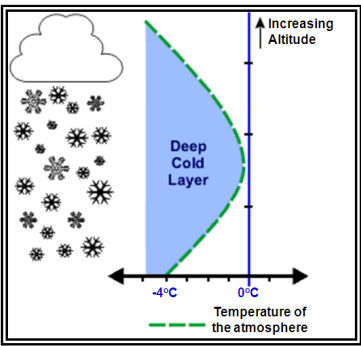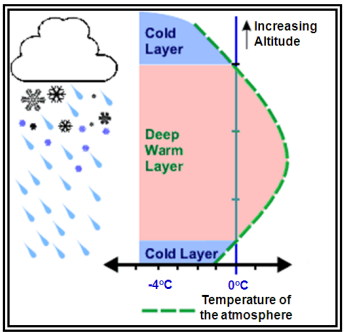Introduction
Precipitation is any of the forms of water particles, whether liquid or solid, that fall from the atmosphere and reach the ground. This chapter covers the necessary ingredients for formation, the growth process, and the types of precipitation. Some precipitation types include: drizzle, rain, freezing rain, freezing drizzle, snow, snow grains, ice crystals, ice pellets, hail, and small hail and/or snow pellets.
Necessary Ingredients for Formation
Precipitation formation requires three ingredients: water vapor, sufficient lift to condense the water vapor into clouds, and a growth process that allows cloud droplets to grow large and heavy enough to fall as precipitation. Significant precipitation usually requires clouds to be at least 4,000 ft thick. The heavier the precipitation, the thicker the clouds are likely to be. When arriving or departing from an airport reporting precipitation of light or greater intensity, expect clouds to be more than 4,000 ft thick.
Growth Process
All clouds contain water, but only some produce precipitation. This is because cloud droplets and/or ice crystals are too small and light to fall to the ground as precipitation. Because of their microscopic size, the rate at which cloud droplets fall is incredibly slow. An average cloud droplet falling from a cloud base at 3,300 ft (1,000 m) would require about 48 hours to reach the ground. It would never complete this journey because it would evaporate within minutes after falling below the cloud base.
Two growth processes exist that allow cloud droplets (or ice crystals) to grow large enough to reach the ground as precipitation before they evaporate (or sublimate). One process is called the collision-coalescence, or warm rain process. In this process, collisions occur between cloud droplets of varying sizes and different fall speeds, sticking together or coalescing to form larger drops. Finally, the drops become too large to be suspended in the air, and they fall to the ground as rain. This is thought to be the primary growth process in warm, tropical air masses where the freezing level is very high.
Most cloud droplets are too small and light to fall to the ground as precipitation. However, the larger cloud droplets fall more rapidly and are able to sweep up the smaller ones in their path and grow.

Figure. The Collision-Coalescence or Warm Rain Process
The other process is called the ice crystal process. This occurs in colder clouds when both ice crystals and water droplets are present. In this situation, it is easier for water vapor to deposit directly onto the ice crystals so the ice crystals grow at the expense of the water droplets. The crystals eventually become heavy enough to fall. If it is cold near the surface, it may snow; otherwise, the snowflakes may melt to rain. This is thought to be the primary growth process in mid-latitudes and high latitudes.
Precipitation Types
Snow
The vertical distribution of temperature will often determine the type of precipitation that occurs at the surface. Snow occurs when the temperature remains below freezing throughout the entire depth of the atmosphere.

Figure. Snow Temperature Environment
Ice Pellets
Ice pellets (sleet) occur when there is a shallow layer aloft with above-freezing temperatures and with a deep layer of below-freezing air based at the surface. As snow falls into the shallow warm layer, the snowflakes partially melt. As the precipitation reenters air that is below freezing, it refreezes into ice pellets.

Figure. Ice Pellets Temperature Environment
Freezing Rain
Freezing rain occurs when there is a deep layer aloft with above-freezing temperatures and with a shallow layer of below-freezing air at the surface. Ordinarily, air temperatures decrease with increasing altitude, but freezing rain requires a temperature inversion, which can occur when a warmer air mass overlies a colder air mass. This situation can occur along a warm front, where a warm air mass overruns a cold air mass. It can begin as rain and/or snow, but becomes all rain in the warm layer. The rain falls back into below-freezing air, but since the depth is shallow, the rain does not have time to freeze into ice pellets. The drops freeze on contact with the ground or exposed objects, such as aircraft.

Figure. Freezing Rain Temperature Environment
Rain
Rain occurs when there is a deep layer of above freezing air based at the surface.

Figure. Rain Temperature Environment
Hail
Hail is precipitation in the form of balls or other irregular lumps of ice produced by thunderstorms. Thunderstorms that are characterized by strong updrafts, large Supercooled Liquid Water Content (SLWC), large cloud-drop sizes, and great vertical height are favorable to hail formation.
Hail forms when supercooled water droplets above the freezing level begin to freeze. Once a droplet has frozen, other droplets latch on and freeze to it, so the hailstone grows—sometimes into a huge iceball. Large hail occurs with severe thunderstorms with strong updrafts that have built to great heights. Eventually, the hailstones fall and may be encountered in clear air several miles from the thunderstorm.
An individual unit of hail is called a hailstone. Hailstones can range in size from a pea (0.25-in diameter) to larger than a softball (4.5-in diameter). Hail competes with turbulence as the greatest thunderstorm hazard to aircraft. Hailstones that are 0.75 in in diameter and larger can cause significant damage to aircraft and make it difficult to control. A hailstone was collected at Vivian, SD, on July 23, 2010, that measured 8 in in diameter, 18.62 in in circumference, and weighed 1.93 lb.
As hailstones fall through air with temperatures above 0 ºC, they begin to melt, and precipitation may reach the ground as either hail or rain. Rain at the surface does not mean the absence of hail aloft. Pilots should anticipate possible hail with any thunderstorm, especially beneath the anvil of a large cumulonimbus.

Figure .Vivian, South Dakota, Record Hailstone
Hail is most frequently found in the interior of continents within the mid-latitudes and generally confined to higher elevations within the tropics. In the United States, hail is most common across the Great Plains region east of the Rocky Mountains. Hail is more common aloft and at higher elevations because the stones begin to melt when they fall below the freezing level, and the smaller stones may melt into raindrops before they reach the surface.
When viewed from the air, it is evident that hail falls in paths known as hail swaths. They can range in size from a few acres to an area 10 mi wide and 100 mi long. Piles of hail in hail swaths have been deep enough to need a snowplow to remove them, and occasionally hail drifts have been reported.





